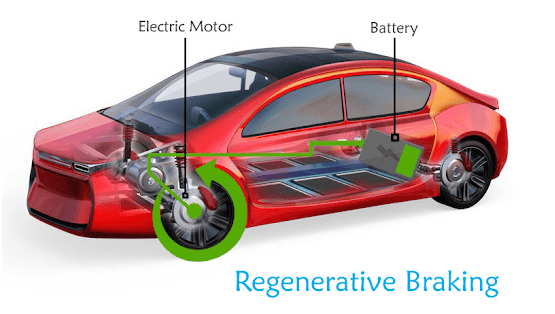Regenerative Braking in Electric Vehicles (GS Paper 3, Science & Technology)

Introduction
- In the landscape of electric vehicles (EVs), regenerative braking stands as a pivotal innovation aimed at enhancing energy efficiency and sustainability.
- Here’s a detailed exploration of regenerative braking, its operational mechanics, advantages, and implications:
Understanding Braking
- Braking in vehicles is the process by which kinetic energy, possessed by a moving vehicle, is converted into another form of energy to slow down or stop.
- Traditionally, this is achieved through frictional mechanisms such as disc brakes or drum brakes, where mechanical energy (kinetic) is transformed into thermal energy (heat).
What is Regenerative Braking?
- Regenerative braking differs significantly from traditional braking methods.
- It harnesses the kinetic energy that would typically be lost as heat during braking and converts it into electrical energy.
- This energy is then stored in the vehicle’s battery or a supercapacitor for later use.
- The process essentially turns the electric motor of the vehicle into a generator during braking phases.
How Does Regenerative Braking Work?
- Reversal of Motor Function: In an electric vehicle, the motor acts as a generator during regenerative braking. When the driver lifts their foot off the accelerator or applies the brake, the motor's operation switches from consuming electricity to propel the vehicle to generating electricity from the kinetic energy of the wheels.
- Energy Storage: The generated electrical energy is directed back into the vehicle's battery pack or a dedicated energy storage unit. This stored energy can then be used to power the vehicle’s electric motor during acceleration or maintain operations when demand for power is high.
- Types of Braking Systems: Alongside regenerative braking, electric vehicles often integrate traditional friction brakes to supplement braking force, especially during emergency stops or at higher speeds where regenerative braking efficiency decreases.
Advantages of Regenerative Braking
- Enhanced Energy Efficiency: By recapturing and reusing kinetic energy that would otherwise be lost, regenerative braking improves the overall energy efficiency of electric vehicles. This is particularly beneficial in urban driving conditions with frequent starts and stops.
- Extended Driving Range: The ability to recover and store energy through regenerative braking contributes to extending the vehicle's driving range on a single charge, reducing the need for frequent recharging.
- Reduced Environmental Impact: Lower energy consumption translates to reduced emissions and environmental impact, aligning with global efforts towards sustainable transportation solutions.
Challenges and Considerations
- Limitations at Lower Speeds: Regenerative braking efficiency decreases at lower speeds, where kinetic energy available for recovery is minimal, necessitating supplementary braking systems.
- Complete Braking Requirement: In certain scenarios, regenerative braking alone may not provide sufficient braking force to bring the vehicle to a complete stop, requiring integration with traditional friction brakes.
- Technological Integration: The successful implementation of regenerative braking requires advanced engineering and seamless integration with the vehicle’s powertrain and control systems.
Future Implications and Conclusion
- Regenerative braking exemplifies the evolving landscape of electric vehicle technology, emphasizing efficiency, sustainability, and innovation.
- As automakers and engineers continue to refine and expand the capabilities of regenerative braking systems, its role in enhancing the performance and environmental credentials of electric vehicles is set to grow.
- This technology not only contributes to reducing operational costs for EV owners but also plays a crucial part in achieving broader environmental and energy sustainability goals worldwide.


